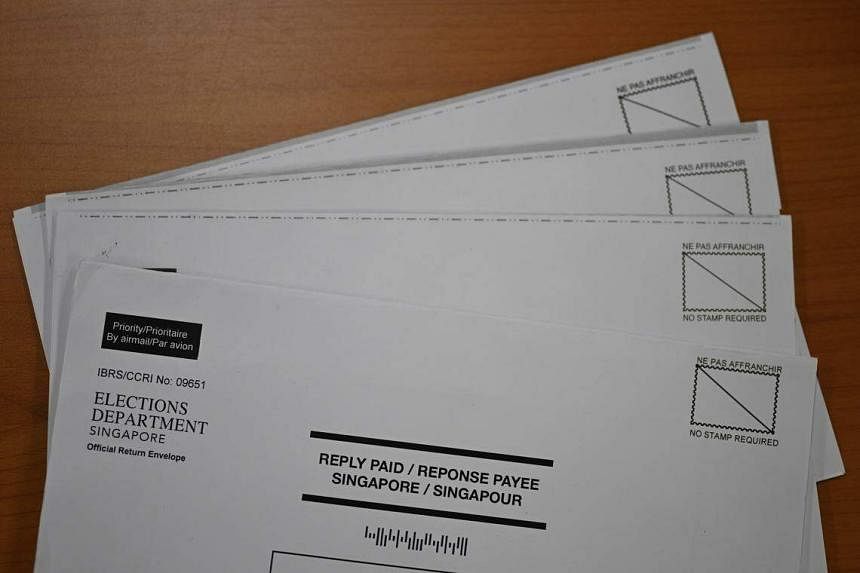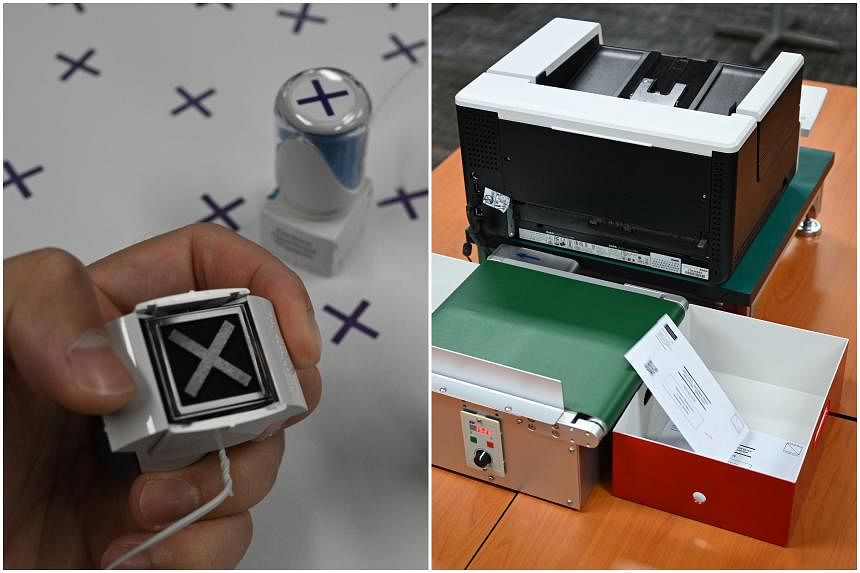SINGAPORE - There will be more polling stations serving residents in the upcoming presidential election, as well as a new stamp to help voters mark their choices on ballot papers.
Voters will also have new convenient ways to check the queue status at polling stations, such as via the QR code on their poll cards.
These were among the improvements to voting arrangements announced by the Elections Department (ELD) on Monday.
ELD said these improvements drew on lessons learnt from the 2020 General Election.
In 2020, ELD had to debunk false claims on Polling Day itself that the then new self-inking X-Pens provided at polling booths did not stamp properly, and that it would render many votes invalid.
Some voters in the previous election had also tried to write a cross with the X-Pen.
ELD said on Monday that it would be introducing a new X-stamp for the upcoming election – one that is wider and more clearly intended to serve as a stamp.
Use of this stamp, while encouraged, is not compulsory. Voters can take along their own pens.
ELD also announced that for the upcoming presidential election, there will be 1,264 polling stations, up from 1,097 in the 2020 election.
In terms of the breakdown, ELD said it has planned for 931 polling stations that cater to up to about 2,500 voters, 209 stations that would be for 2,501 to 3,000 voters, and 124 stations that would be for 3,001 to 3,500 voters.
With the increase in polling stations, the number of voters allocated to each one will be reduced to an average of 2,150, from 2,400 before.
Each polling station will also have more registration counters and ballot paper counters to reduce voter waiting time.
Around 36,000 election officials will be deployed, up about 20 per cent from 30,000 previously.
In the 2020 General Election, a VoteQ website allowed voters to check on the queue status at polling stations. Voters had to remember the URL and key it in to access the site.
In the upcoming presidential election, voters will be able to access VoteQ through a hyperlink on the ePoll card on their Singpass app.
They can also scan the QR code on their physical poll card, which will be mailed to them after Nomination Day, if the election is contested.

In 2020, ELD also made the unprecedented move to extend voting hours for the general election till 10pm, following reports of several polling stations across the island seeing long queues during the day.
The polls were initially scheduled to close at 8pm.
There are currently three presidential hopefuls – former senior minister Tharman Shanmugaratnam, entrepreneur George Goh and former GIC investment chief Ng Kok Song.
Update on postal voting
ELD had earlier announced the introduction of postal voting at the upcoming presidential election.
It said on Monday that it had conducted a postal voting trial with about 160 overseas Singaporeans in March.
Most participants found it easy to register for postal voting, as well as to download and print their postal ballot papers via ELD’s voter services on its website.
The department also conducted a separate trial, with the support of Singapore overseas missions and overseas offices of the Economic Development Board, Singapore Global Network and Enterprise Singapore, to better understand how foreign postal services operate.
From these trials, ELD found that some return envelopes it received did not bear a postmark. The mark is necessary to ensure the vote was cast before the results of the local vote counts are known.
Some return envelopes from certain regions or countries also took a longer time to reach Singapore.
The trial also found that some signatures submitted during registration could not be readily matched by the Signature Scanning and Verification System (SSVS) machine.
For example, signature images were blurred, or signatures were made on sheets of paper that were crumpled, lined or not white.
ELD suggested that postal voters in certain regions or countries should consider affixing postal stamps on their return envelopes to help ensure their envelopes are postmarked.
These locations are:
- Middle Eastern countries: Israel, Oman, Saudi Arabia, Turkey, United Arab Emirates
- Oceania countries: Australia, New Zealand
- South-east Asian countries: Cambodia, Indonesia, Laos, Thailand, Vietnam
- Others: Bangladesh, Belgium, Brazil, Ghana, India, South Korea, Taiwan
Overseas Singaporeans who opt for postal voting must ensure that their return envelopes with their marked postal ballot papers reach the custody of the returning officer no later than 10 days after Polling Day.
ELD said that on the day overseas votes are counted, return envelopes that cannot be counted will be sieved out.
These include torn envelopes or those with late postmarks.
The SSVS machine will authenticate each return envelope via a unique QR code printed on it and match the signature on the return envelope against what was submitted by the voter during registration.
Envelopes that are rejected by the machine will be checked manually by election officials.
Those that pass the authentication phase via machine or election official will have their postal ballot papers retrieved from the envelopes for counting.
These postal ballots will be mixed with those cast at overseas polling stations before counting.
Overseas Singaporeans whose names are in the Registers of Electors can already register for overseas voting and choose to vote by post or in-person at an overseas polling station.
There are 10 overseas stations: New York, Washington, San Francisco, London, Shanghai, Beijing, Hong Kong, Tokyo, Canberra and Dubai.
To be eligible for overseas voting, overseas Singaporeans must also meet the residency requirement of residing in Singapore for an aggregate of at least 30 days in the last three years.
The law was recently amended that this requirement has to be met before the date of registration to be an overseas voter, rather than by the prescribed date for the revision of the Registers of Electors, which was on June 1, 2023.
Registration for overseas voting is currently open and will close on the second day after the Writ of Election is issued.


